|
Size: 11727
Comment:
|
Size: 15894
Comment: update on the simbio tutorial advanced options
|
| Deletions are marked like this. | Additions are marked like this. |
| Line 2: | Line 2: |
| '''[TUTORIAL UNDER DEVELOPMENT: NOT READY FOR PUBLIC USE]''' | ''Authors: [[https://neuroimage.usc.edu/brainstorm/AboutUs/tmedani|Takfarinas Medani]], Juan Garcia-Prieto, Francois Tadel, Sophie Schrader, Anand Joshi, Christian Engwer, Carsten Wolters, John Mosher and Richard Leahy '' |
| Line 4: | Line 4: |
| ''Authors: Takfarinas, Juan, François ...Sophie, Johannes, Maria, Christian, Carsten, John, Richard ? '' | {{attachment:logo_duneuro.png||align="right",height="82",width="187"}} |
| Line 6: | Line 6: |
| This tutorial explains how to use brainstorm-dueneuro to compute the head model using the finite element method (FEM). | This tutorial explains how to use [[https://www.medizin.uni-muenster.de/duneuro/startseite.html|DUNEuro]] to compute the forward model using the '''finite element method''' ('''FEM'''). The FEM methods use a realistic volume mesh of the head generated from the segmentation of the MRI. The FEM models provide more accurate results than the spherical forward models and more realistic geometry and tissue properties than the [[Tutorials/TutBem|BEM]] methods. Its applications include accurate source localization in MEG/EEG/sEEG/ECoG and TMS/TDCS optimizations. |
| Line 8: | Line 8: |
| This forward model uses the FEM method implemented within the [[http://duneuro.org/|Duneuro]] software. More documentation could be found on this [[https://gitlab.dune-project.org/duneuro/duneuro/wikis/home|gitlab page]]. | The scope of this page is limited to a '''basic example''' (head model with 3 layers). More advanced options for mesh generation and forward model computation are discussed in other tutorials: [[Tutorials/FemMesh|FEM mesh generation]], [[Tutorials/FemTensors|FEM tensors estimation]], [[Tutorials/FemMedianNerve|FEM median nerve example]]. We assume that you have already followed the [[Tutorials|introduction tutorials]], we will not discuss the general principles of forward modeling here. |
| Line 10: | Line 10: |
| The FEM methods use the realistic volume mesh of the head model genertaed from the segmentation of the magnetic reasonance images (MRI). The FEM forward solution provides more accurate results than the spherical models and more realistic geometry and tissu propriety than the BEM. ''In this tutorial we will describe the software requirement to use the DUNEuro computation from brainstrom and examples on the FEM computation through the graphical interface. '' |
<<TableOfContents(2,2)>> |
| Line 15: | Line 13: |
| [[http://duneuro.org/|DUNEuro]] is an open-source C++ software library for solving partial differential equations (PDE) in neurosciences using mesh bases methods. It is based on the [[https://www.dune-project.org/|DUNE library]] and its main features that include solving the electroencephalography (EEG) and magnetoencephalography (MEG) forward problem and providing simulations for brain stimulation. {{attachment:duneuroFromDune2.png|height="50",width="120"}} | '''[[https://www.medizin.uni-muenster.de/duneuro/startseite.html|DUNEuro]] '''is an open-source C++ software library for solving partial differential equations (PDE) in neurosciences using mesh-based methods. It is based on the''' [[https://www.dune-project.org/|DUNE library]] '''and its main features include solving the EEG and MEG forward problem and providing simulations for brain stimulation. |
| Line 17: | Line 15: |
| == Citing DUNEuro == Please cite following papers if you use this software tool or its derivatives in your own work. |
As distributed on the [[http://gitlab.dune-project.org/duneuro/duneuro|DUNEuro GitLab]], the source code works only on Linux operating systems. Interfaces to Matlab and Python are possible, but you need to install and compile DUNEuro by yourself. For Brainstorm, we adapted this code and were able to generate '''binaries''' for the main operating systems''' '''(Windows, '''Linux '''and MacOS), which are '''downloaded automatically''' when needed as a [[Tutorials/Plugins|Brainstorm plugin]]. This project is available on our [[https://github.com/brainstorm-tools/bst-duneuro|GitHub repository bst-duneuro]]. |
| Line 20: | Line 17: |
| Andreas Nüßing, Maria Carla Piastra, Sophie Schrader, Tuuli Miinalainen, Sampsa Pursiainen, Heinrich Brinck, Carsten H. Wolters, Christian Engwer | We would like to thank the''' DUNEuro team '''for their help with this integration work: Carsten Wolters, Christian Engwer, Sophie Schrader, Andreas Nuessing, Yvonne Buschermöhle, Tim Erdbruegger, Marios Antonakakis, Johannes Vorwerk & Maria Carla Piastra. |
| Line 22: | Line 19: |
| ''"duneuro - A software toolbox for forward modeling in neuroscience"'' under review | ''' {{attachment:duneuroFromDune.JPG||height="187",width="546"}} ''' |
| Line 24: | Line 21: |
| ''"The Brainstrom-Duneuro : friendely interface for the EEG/MEG with the Finite Elelemt Method"'' | If you use Brainstorm-DUNEuro please '''cite the following papers''' in your work: |
| Line 26: | Line 23: |
| under writing | * Schrader, S., Westhoff, A., Piastra, M.C., Miinalainen, T., Pursiainen, S.,Vorwerk, J., Brinck, H., Wolters, C.H., Engwer, C., DUNEuro- A software toolbox for forward modeling in bioelectromagnetism, PLoS ONE, 16(6):e0252431 (2021). doi: [[https://urldefense.com/v3/__https://doi.org/10.1371/journal.pone.0252431__;!!LIr3w8kk_Xxm!-bMXySp_3t41y5-tXZHEiMKGFE32SAMz93NulthzqfHf4uA7QstTC15r64oFpQ$|https://doi.org/10.1371/journal.pone.0252431]] * Medani, T., Garcia-Prieto, J., Tadel, F., Schrader, S. Antonakakis, M., Joshi, A., Engwer, C., Wolters, C.H., Mosher, J., Leahy, R., "Realistic head modeling of electromagnetic brain activity: an integrated Brainstorm-DUNEuro pipeline from MRI data to the FEM solutions," Proc. SPIE 11595, Medical Imaging 2021: Physics of Medical Imaging, 1159554 (15 February 2021);https://doi.org/10.1117/12.2580935 |
| Line 28: | Line 26: |
| == Software requirements == === FEM Computation : DUNEuro === In order to use the FEM computation, Brainstorm call the DUNEuro Th DUNEuro binaries are distributed within the [[https://github.com/brainstorm-tools/bst-duneuro|bst-duneuro toolbox]]. These binaries are adapted and tested for Windows, MAC and Linux 64bit systems. Therefore you don't need to install any extra software package to run the FEM computation, brainstorm will do it for you'''.''' |
If you want to learn more about DUNEuro, please visit to the following web pages: |
| Line 32: | Line 28: |
| === FEM head model : Mesh generation === In order to use the FEM computation of the electromagnetic field (EEG/MEG), the volume mesh of the head is required. Brainstorm integrates most of the modern open source tools used to generate realistric head mesh, either from nested surface mesh or from individual MR image (T1 or T1 and T2). The list of the available methods are listed and explained on [[https://neuroimage.usc.edu/brainstorm/meshGeneration#preview|this tutorial]]. |
* [[https://www.medizin.uni-muenster.de/duneuro/forschung.html|DUNEuro main website]] * [[https://www.medizin.uni-muenster.de/duneuro/forschung.html|DUNEuro publications]] |
| Line 35: | Line 31: |
| New mthods are under devellopement and will be released to brainstorm in next future. | == Requirements == In order to reproduce the computation present below on your computer, you need to fulfill all the conditions listed below. Alternatively, you can read this page as a reference documentation about DUNEuro and not try to reproduce the results. |
| Line 37: | Line 34: |
| === FEM head model : Mesh visualisation === The FEM mesh visualisation and mesh processing option are integrated with brainstorm. The use of these options equires the installation of the [[http://iso2mesh.sourceforge.net/cgi-bin/index.cgi?Download|iso2mesh]]. Brainstrom will download the last release from this [[https://neuroimage.usc.edu/brainstorm/http://iso2mesh.sourceforge.net/cgi-bin/index.cgi?Download|webpage]] and install it when it'is needed. However, you can also download the iso2mesh from the [[https://github.com/fangq/iso2mesh|github]] and add it to your matlab path.. |
* You have a working copy of Brainstorm installed on your computer. * You have already followed the [[https://neuroimage.usc.edu/brainstorm/Introduction|introduction tutorials]], at least until #23. * You have followed the tutorial [[https://neuroimage.usc.edu/brainstorm/Tutorials/Epilepsy|EEG and Epilepsy]], as it is used for illustrating the computation. * '''DUNEuro''': Software installed automatically as a [[https://neuroimage.usc.edu/brainstorm/Tutorials/Plugins|Brainstorm plugin]]. * '''Iso2mesh''': Software installed automatically as a [[https://neuroimage.usc.edu/brainstorm/Tutorials/Plugins|Brainstorm plugin]]. |
| Line 40: | Line 40: |
| === FEM and tissu anisotropy : Brainsuite === Among the advantages of the FEM, the use of the tissu anisotropy (conductivity). The estimation of the tissu anisotropy is performed with the brainsuite diffusion pipline (BDP '''link'''). The diffusion tensor images are estimated with brainsuite and then converted to conductivity tensor using the '''Tuch ''' . In order to use this option, you need to install brainsuite software, the rest of the process are distributed within bst-duneuro. |
== FEM mesh == In order to use the FEM computations of the electromagnetic field (EEG/MEG), the volume mesh of the head is required. Brainstorm integrates most of the modern open-source tools to generate realistic head mesh, either from nested surface mesh or from individual MR images (T1 or T1 and T2). This tutorial describes only a simple approach based on three nested surfaces meshed in 3D with Iso2mesh. For the full list of available methods and description of options, please refer to the tutorial [[https://neuroimage.usc.edu/brainstorm/Tutorials/FemMesh|FEM mesh generation]].''' ''' |
| Line 43: | Line 43: |
| <<BR>>'''<<TAG(Advanced)>>''' <<BR>> | * Select the protocol TutorialEpilepsy, created while following the tutorial [[Tutorials/Epilepsy|EEG and epilepsy]]. * Go to the anatomy view. * Select the three [[https://neuroimage.usc.edu/brainstorm/Tutorials/TutBem#BEM_surfaces|BEM surfaces]]: scalp, outer skull, inner skull. * Right-click > '''Generate FEM mesh''' > Iso2mesh-2021 > MergeMesh > Default options. <<BR>><<BR>> {{attachment:femMesh1.gif}} <<BR>> {{attachment:iso2mesh.gif}} ''' ''' * The FEM mesh appears in the database explorer after a short while. The first number indicates the number of vertices (i.e. nodes) of the tetrahedral mesh. To get the number of 3D elements (i.e. tetrahedrons) in this geometric model of the head: right-click on the file > File > View file contents. The structure of the file is describe in the tutorial [[https://neuroimage.usc.edu/brainstorm/Tutorials/FemMesh#On_the_hard_drive|FEM mesh generation]].<<BR>><<BR>> {{attachment:femMesh2.gif}} * Double-click on the FEM file to display it. From the Surface tab, you can change the resection locations by moving the bottom sliders, and you can control the display of each of the three layers individually. Click on the layer button in the toolbar, then adjust the color and transparency of the corresponding mesh. The figure below represents the FEM mesh in the center and the initial BEM layers on the right. <<BR>><<BR>> {{attachment:femMesh3.gif}} |
| Line 45: | Line 50: |
| * DUNEuro software is built on top of the DUNE Library. The Duneuro [[https://gitlab.dune-project.org/duneuro/duneuro|source code]] works only on Linux operating systems. However, we were able to generate the binaries for the main platforms (windows 64, Linux and Mac), thus, it can be easily used from brainstorm and Matlab without the need to install and compile the tediuos Dune and Duneuro libraries on your computer. * The main process of the Duneuro compilation used for brainstorm are explained [[https://github.com/brainstorm-tools/bst-duneuro|here]] |
== FEM forward model == The '''forward model''' (or '''head model''' in the Brainstorm documentation and interface) describes how the electric activity in the '''source space''' (the cortex surface or a regular grid of volume points) influences the electric potential (EEG) or magnetic fields (MEG) at the level of the '''sensors'''. The FEM method uses the '''tetrahedral mesh''' computed above to establish this relationship. ''' ''' |
| Line 48: | Line 53: |
| * When you use any options related to the FEM computation, brainstrom will download and install the [[https://github.com/brainstorm-tools/bst-duneuro|bst-duneuro toolbox]] and all the related toolbox on your computer (iso2mesh, brain2mesh ...). * The [[https://simnibs.github.io/simnibs/build/html/documentation/documentation.html|SimNibs]] (for FEM mesh geneation from MR images) and [[http://brainsuite.org/|Brainsuite]] (for anistropy tensor estimation from DWI) should be installed manually on the user's computer. |
* Go the Anatomy view. Select the default FEM mesh and cortex surface you'd like to use for the computation (in case there is more than one in each category). The selected elements appear in green, double-click or right-click > Set as default to change the selection. * Go to the Functional view. Right-click on the channel file > '''Compute head model'''. <<BR>><<BR>> {{attachment:femCompute1.gif}} * Select '''MRI volume''', EEG: '''DUNEuro FEM''', select all the layers and the default conductivity values (scalp = inside the head surface, skull = inside the outer skull surface, brain = inside the inner skull surface).<<BR>><<BR>> {{attachment:femCompute2.gif}} * Volume source grid: '''Regular grid''', brain, 5mm. {{attachment:femCompute3.gif}} * Start the computation. Depending on the complexity of the problem (number of FEM elements, number of layers, number of source points, number of sensors and computation options), this can take anywhere between a few minutes to a few days. In this example, if you selected the correct files and options, it should only take a few minutes. You may be prompted to download or update the bst-duneuro [[https://neuroimage.usc.edu/brainstorm/Tutorials/Plugins|plugin]]. <<BR>><<BR>> {{attachment:femCompute4.gif}} * When it's finished, you have obtain a new head model, which can be used for source estimation: see the [[https://neuroimage.usc.edu/brainstorm/Tutorials/Epilepsy#Source_analysis:_Volume|epilepsy tutorial]], the [[https://neuroimage.usc.edu/brainstorm/Tutorials/TutVolSource|volume source estimation]] tutorial, or the [[https://neuroimage.usc.edu/brainstorm/Tutorials/SourceEstimation|introduction tutorial]]. |
| Line 51: | Line 60: |
| == FEM surfaces / Volume generation == === Volume mesh generation from Brainstorm === The most modern software that are used to generate the volume mesh head model are integrated within brainstorm with an easy graphical interface to use call these tools. |
<<TAG(Advanced)>> |
| Line 55: | Line 62: |
| Right click on the subject and then "Generate FEM Mesh" | == DUNEuro options: Basic == When assuming '''isotropic conductivities''' for all the tissues, the DUNEuro basic options are limited to the selection of the tissues and their conductivities. |
| Line 57: | Line 65: |
| {{attachment:menuGenerateFemMesh.PNG|height="40",width="150"}} | . {{attachment:duneuroBasic.gif}} {{attachment:duneuroTensors.gif}} |
| Line 59: | Line 67: |
| The available options are : | * '''FEM layers: '''Brainstorm reads the lists of tissues from the selected FEM mesh. Users can select the desired layers to include in the FEM computation. According to the modalities, the recommended selections are: * '''EEG''': Select all the layers * '''MEG''': Select only the inner layers (inside the inner skull = brain = white+gray+csf) * '''SEEG''': Select only the inner layers * '''ECOG''': Select only the inner layers * Any combination of modalities that includes MEG: select all the layers |
| Line 61: | Line 74: |
| . {{attachment:FemMeshMethods.PNG|height="50",width="100"}} | * '''FEM conductivities (isotropic):''' Left figure - Brainstorm proposes default conductivity values for each layer (derived from the SimBio software, see [[https://www.mrt.uni-jena.de/simbio/images/VorwerkChoRamppHamerKnoescheWolters_NeuroImage_2014_Webversion.pdf|this article]]). However, you have the possibility to change these values according to your model. |
| Line 63: | Line 76: |
| "Iso2mesh" : This option merges the brainstorm surfaces available on the subject and then generarte the tetrahedral mesh. | * '''FEM conductivities (anisotropic)''': Right figure - Advanced users can use information from '''diffusion imaging''' exams to estimate anisotropic '''conductivity tensors''' for each element of the FEM mesh. For more information, refer to the tutorial: [[https://neuroimage.usc.edu/brainstorm/Tutorials/FemTensors|FEM tensors estimation]]. To remove previously computed tensors and restore the default isotropic approach, right-click on the FEM mesh > Clear FEM tensors. <<BR>><<BR>> {{attachment:clearFemTensors.JPG||height="300",width="220"}} |
| Line 65: | Line 78: |
| "Brain2Mesh" : This options uses the MRIs available on the subjects, then it calls the SPM segmentation of the volume into 5 tissus (white, gray, scf, skull and skin). After that it converts into a tetrahedral mesh. | <<TAG(Advanced)>> |
| Line 67: | Line 80: |
| "SimNibs" : The recommended option, it calls the headreco {ref} and generate a FEM head model | == DUNEuro options: Advanced [TODO] == In the DUNEuro options panel, click on the button '''Show details''' to access the advanced options. |
| Line 69: | Line 83: |
| "FieldTrip" : (in progress) "Roast" : (in progress) | . {{attachment:duneuroAdvanced.gif}} |
| Line 71: | Line 85: |
| "headreco" : | * '''FEM layers & conductivities''': Discussed in the previous section. |
| Line 73: | Line 87: |
| https://simnibs.github.io/simnibs/build/html/documentation/command_line/headreco.html | * '''FEM solver type''': (only the fitted FEM are integrated in Brainstorm at the moment) * '''CG''': Continuous Galerkin: the standard Lagrangian method. |
| Line 75: | Line 90: |
| This function is part of the SimNibs software: | * '''DC''': Discontinuous Galerkin: method that deals with some problems that appear occasionaly during meshing of very thin volumes. DC enforces a realistic modeling of the volume currents to attempt to mitigate these problems. |
| Line 77: | Line 92: |
| https://simnibs.github.io/simnibs/build/html/index.html | * '''FEM source model''': * '''Venant''': * Number of moments: * Reference length: * Weighting exponent: * Relaxation factor exponent: * Mixed moment: * Restrict: * '''Subtraction''': * intorderadd: * intorderadd_lb: * '''Partial integration''': * '''Source space''': * '''Shrink source space''': The dipoles are moved inward by the specified distance (in mm). * '''Force source space''': This is required when the dipoles are not within the gray matter. * '''Output options''': * '''Save transfer matrix''': |
| Line 79: | Line 110: |
| === headreco === The headreco function is fully integrated to brainstorm. With this option, brainstorm can reconstructs a tetrahedral head mesh from T1- and T2-weighted structural MR images. It runs also with only a T1w image, but it will achieve more reliable skull segmentations when a T2w image is supplied. |
For more information about these methods, users can check [[https://www.sci.utah.edu/~wolters/PaperWolters/2016/Vorwerk_Dissertation_2016.pdf|Johannes Vorwerk's PhD thesis]]. |
| Line 82: | Line 112: |
| === Surface mesh generation from volume mesh === === Volume generation from surface files === In this part you can generate your FEM mesh from surfaces that you can get fron the segmentation software (brainSuite, FreeSurfer ....). |
<<TAG(Advanced)>> |
| Line 86: | Line 114: |
| This process will | == Troubleshooting == DUNEuro binaries may crash for various reasons. We will try to describe the most frequent problems, however, in general terms, FEM forward modeling problems can be related with memory overload or extremely long computation times. For this reason it is always a good idea to reduce the size of the problem and test simpler solutions first, before attempting a fine grained computation. |
| Line 88: | Line 117: |
| - merge the surfaces, | If you cannot find a solution, please post the full error message on the Brainstorm user forum (you can copy-paste the error message from the Matlab command window after closing the error message box). |
| Line 90: | Line 119: |
| - check the self intersecting | === Grid error messages === {{{ }}} * Explanation: Some dipoles are probably outside of the cortex, users need to correct the source space. * Try redefining the source model by making sure that the sources are not located out of the cortical volume. |
| Line 92: | Line 125: |
| - fixe the size of the mesh | === Remove the neck === One way to reduce the size of the forward problem is to decrease the number of FEM elements in the head model. When the field of the MRI is large, you may have the mesh of the neck and even the shoulders. In most cases, it is safe to remove the lower part of the FEM mesh, below the nose and the brainstem. Right-click on the FEM mesh > '''Resect Neck'''. |
| Line 94: | Line 128: |
| - generate the volum mesh | {{attachment:resectNeck.JPG||height="150",width="600"}} |
| Line 96: | Line 130: |
| - visual checking ... | Once the process is finished, a new FEM mesh appears in the database, with a tag "resect". The following figure shows the model before (743828 vertices / 4079587 elements) and after resection (613955 vertices / 3400957 elements). It will reduce the size of the problem by 20%. |
| Line 98: | Line 132: |
| - TODO : may be we can add some mesh auqlity measures ?? | {{attachment:FemMeshAllandResect.JPG||height="150",width="600"}} |
| Line 100: | Line 134: |
| '''<<TAG(Advanced)>>''' | === Linux Operating Systems: === Some users have reported the following error when computing the head model with DUNEuro in Linux OS. |
| Line 102: | Line 137: |
| === Volume generation from T1/T2 MRI data === You can also generate your own FEM head model and then load it to brainstorm. However the automatic head model generation from from imaging techniques are not accurate and most of the time visual checking are needed and manual correction are required. |
{{{ Error while loading shared libraries: libldl.so.2: cannot open shared object file: No such file or directory }}} The problem is that DUNEuro requires some libraries in order to work properly. These dependencies should be in a folder where they can be located. The error message occurs when this dependencies eithera are missing in your system or in your path. In order to solve it, you can try to find any library with the same name. Be careful, ''libdl.so'' and ''libldl.so'' are not the same thing. |
| Line 105: | Line 142: |
| ==> this depends lagely on the quality of the T1/T2 MRI image(https://simnibs.github.io/simnibs/build/html/tutorial/head_meshing.html). | {{{ find -name "libldl*" /usr }}} If you find a ''libldl'' library, but it is not in the correct path, try copying the library (or a link to it) to ''/usr/lib''. |
| Line 107: | Line 147: |
| This step is based on the "roast" toolbox (link to roast : https://github.com/andypotatohy/roast | If you cannot find any related library in your system, try installing the following packages to force that dependency being installed in your system. For instance, in Ubuntu you can run: |
| Line 109: | Line 149: |
| ) that we adapted for the MEEG forward computation. If you want to generate your own FEM head model from an MRI, you will need to download these file (link), then run the bst process as explained here. | {{{ sudo apt install libldl2 libspar2 libdune-grid-dev libdune-istl-dev }}} == Additional documentation == ==== Related tutorials ==== * [[Tutorials/FemMesh|FEM mesh generation]] * [[Tutorials/FemTensors|FEM tensors estimation]] * [[Tutorials/FemMedianNerve|FEM median nerve example]] |
| Line 111: | Line 158: |
| * f there is a MRI file with the string "T2" in the subject anatomy folder, it will use it * Otherwise, if you select explicitly two MRI files with CTRL+Click, it will use the first one as the T1 and the second one as the T2 (this needs to be documented in the tutorial) |
==== DUNEuro references ==== * DUNEuro wiki: https://gitlab.dune-project.org/duneuro/duneuro/wikis/home * DUNEuro website: https://www.medizin.uni-muenster.de/duneuro/startseite.html * List of the parameters: https://docs.google.com/spreadsheets/d/1MqURQsszn8Qj3-XRX_Z8qFFnz6Yl2-uYALkV-8pJVaM/edit#gid=0 |
| Line 114: | Line 163: |
| === FEM Head model generation with SimNibs === This method used the SimNibs software. So to call this process, you need to download and install the SimNibs software, the process of the installation is explained in the SimNibs webpage : https://simnibs.github.io/simnibs/build/html/installation/simnibs_installer.html. |
==== Brainstorm-DUNEuro integration ==== * https://github.com/brainstorm-tools/bst-duneuro/issues/1 * https://github.com/brainstorm-tools/brainstorm3/issues/242 * https://github.com/brainstorm-tools/brainstorm3/issues/185 |
| Line 117: | Line 168: |
| When you have installed SimNibs, Brainstorm can call the main function used for the mesh generation frm the main graphical interface. Depemding on your computer performances, this process will take between 2 to 5 hours. We highly recommend to close all other running process and application on our computer in order to speed this process. | '''Brainstorm user forum''' |
| Line 119: | Line 170: |
| - Explain here the main steps with screenshots : 1- Create new subject within the current protocole 2- Load the T1 of the subject to the brainstorm database. 3- Associate a T2 mri to the subject if it's available (this is better for csf/skull/scalp segmentation) 4- Right click on the subject, select the "Generate FEM mesh" . Select "SIMNIBS", and choose "Tetrahedral element" and keep the other options to the default value. 5- When this process is finished, a new node will appear in the data base, which hase he name "FEM xxxV, (simNibs, yLayers)". This is the FEM mesh model generated from the T1. === FEM Head model template === - Load the FEM volumic mesh (template created from ICBM T1 MRI using SimNibs) - Load the surface mesh (template created also from ICBM using ICBM ) and then generates the volume mesh (either tetra or hexa) by calling the tetgen process cia iso2mesh toolbox (if hexa are desired, the tetra mesh will be converted to hexa ... ) https://github.com/brainstorm-tools/brainstorm3/issues/185#issuecomment-576749612 === Head model based on the level set approach === TODO and Validate if users want to use freesurfer and simnibs, the priority is given to freesurfer, then load the fs files, then call simnibs headmodel generation from t1/t2. == FEM computation and interface to DUNEuro == === Head model === Number of layers, conductivity value, isotropy/anisotropy/ mesh resolution/ === Electrode model === Check the position of the electrodes and align to the head model (projection if needed) === Source model === Similarly to the spherical nad BEM head model, the source position are defined on the cortex surface vertices. We can either define a contraned or not constrained orientation. However, for the FEM model, more paramters could be tuned for the source model. Choice of the source model : PI, Venant, Subtraction, Whitney Panel of the options choice that the user can select. (other wise we will set to default ) '''<<TAG(Advanced)>>''' === Advanced paramaters === - Solver parameters - Electrodes projection - maybe explain here the relevant option of the mini file ?? == Additional documentation == refer to : http://duneuro.org/ https://www.dune-project.org/ https://simnibs.github.io/simnibs/build/html/index.html == Reported Errors & alternative solution == '''<<TAG(Advanced)>>''' simnibs pblm : https://simnibs.github.io/simnibs/build/html/installation/throubleshooting.html == The MEEG forward problem with the FEM == == License == == Reference == == Additional documentation == https://github.com/brainstorm-tools/bst-duneuro/issues/1 https://github.com/brainstorm-tools/brainstorm3/issues/242 https://github.com/brainstorm-tools/brainstorm3/issues/185 |
* Sources in white matter: https://neuroimage.usc.edu/forums/t/each-source-is-in-which-layer-of-the-mesh/31887/10 |
Realistic head model: FEM with DUNEuro
Authors: Takfarinas Medani, Juan Garcia-Prieto, Francois Tadel, Sophie Schrader, Anand Joshi, Christian Engwer, Carsten Wolters, John Mosher and Richard Leahy

This tutorial explains how to use DUNEuro to compute the forward model using the finite element method (FEM). The FEM methods use a realistic volume mesh of the head generated from the segmentation of the MRI. The FEM models provide more accurate results than the spherical forward models and more realistic geometry and tissue properties than the BEM methods. Its applications include accurate source localization in MEG/EEG/sEEG/ECoG and TMS/TDCS optimizations.
The scope of this page is limited to a basic example (head model with 3 layers). More advanced options for mesh generation and forward model computation are discussed in other tutorials: FEM mesh generation, FEM tensors estimation, FEM median nerve example. We assume that you have already followed the introduction tutorials, we will not discuss the general principles of forward modeling here.
Contents
DUNEuro
DUNEuro is an open-source C++ software library for solving partial differential equations (PDE) in neurosciences using mesh-based methods. It is based on the DUNE library and its main features include solving the EEG and MEG forward problem and providing simulations for brain stimulation.
As distributed on the DUNEuro GitLab, the source code works only on Linux operating systems. Interfaces to Matlab and Python are possible, but you need to install and compile DUNEuro by yourself. For Brainstorm, we adapted this code and were able to generate binaries for the main operating systems (Windows, Linux and MacOS), which are downloaded automatically when needed as a Brainstorm plugin. This project is available on our GitHub repository bst-duneuro.
We would like to thank the DUNEuro team for their help with this integration work: Carsten Wolters, Christian Engwer, Sophie Schrader, Andreas Nuessing, Yvonne Buschermöhle, Tim Erdbruegger, Marios Antonakakis, Johannes Vorwerk & Maria Carla Piastra.
If you use Brainstorm-DUNEuro please cite the following papers in your work:
Schrader, S., Westhoff, A., Piastra, M.C., Miinalainen, T., Pursiainen, S.,Vorwerk, J., Brinck, H., Wolters, C.H., Engwer, C., DUNEuro- A software toolbox for forward modeling in bioelectromagnetism, PLoS ONE, 16(6):e0252431 (2021). doi: https://doi.org/10.1371/journal.pone.0252431
Medani, T., Garcia-Prieto, J., Tadel, F., Schrader, S. Antonakakis, M., Joshi, A., Engwer, C., Wolters, C.H., Mosher, J., Leahy, R., "Realistic head modeling of electromagnetic brain activity: an integrated Brainstorm-DUNEuro pipeline from MRI data to the FEM solutions," Proc. SPIE 11595, Medical Imaging 2021: Physics of Medical Imaging, 1159554 (15 February 2021);https://doi.org/10.1117/12.2580935
If you want to learn more about DUNEuro, please visit to the following web pages:
Requirements
In order to reproduce the computation present below on your computer, you need to fulfill all the conditions listed below. Alternatively, you can read this page as a reference documentation about DUNEuro and not try to reproduce the results.
- You have a working copy of Brainstorm installed on your computer.
You have already followed the introduction tutorials, at least until #23.
You have followed the tutorial EEG and Epilepsy, as it is used for illustrating the computation.
DUNEuro: Software installed automatically as a Brainstorm plugin.
Iso2mesh: Software installed automatically as a Brainstorm plugin.
FEM mesh
In order to use the FEM computations of the electromagnetic field (EEG/MEG), the volume mesh of the head is required. Brainstorm integrates most of the modern open-source tools to generate realistic head mesh, either from nested surface mesh or from individual MR images (T1 or T1 and T2). This tutorial describes only a simple approach based on three nested surfaces meshed in 3D with Iso2mesh. For the full list of available methods and description of options, please refer to the tutorial FEM mesh generation.
Select the protocol TutorialEpilepsy, created while following the tutorial EEG and epilepsy.
- Go to the anatomy view.
Select the three BEM surfaces: scalp, outer skull, inner skull.
Right-click > Generate FEM mesh > Iso2mesh-2021 > MergeMesh > Default options.
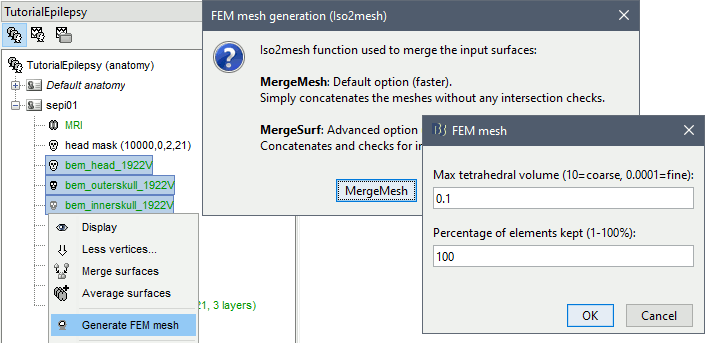
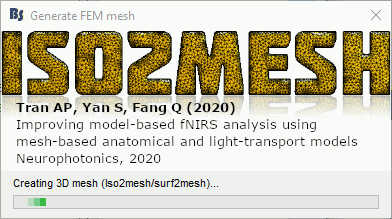
The FEM mesh appears in the database explorer after a short while. The first number indicates the number of vertices (i.e. nodes) of the tetrahedral mesh. To get the number of 3D elements (i.e. tetrahedrons) in this geometric model of the head: right-click on the file > File > View file contents. The structure of the file is describe in the tutorial FEM mesh generation.

Double-click on the FEM file to display it. From the Surface tab, you can change the resection locations by moving the bottom sliders, and you can control the display of each of the three layers individually. Click on the layer button in the toolbar, then adjust the color and transparency of the corresponding mesh. The figure below represents the FEM mesh in the center and the initial BEM layers on the right.
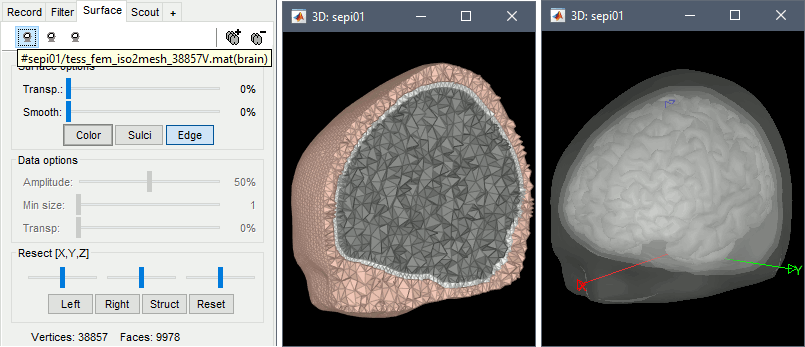
FEM forward model
The forward model (or head model in the Brainstorm documentation and interface) describes how the electric activity in the source space (the cortex surface or a regular grid of volume points) influences the electric potential (EEG) or magnetic fields (MEG) at the level of the sensors. The FEM method uses the tetrahedral mesh computed above to establish this relationship.
Go the Anatomy view. Select the default FEM mesh and cortex surface you'd like to use for the computation (in case there is more than one in each category). The selected elements appear in green, double-click or right-click > Set as default to change the selection.
Go to the Functional view. Right-click on the channel file > Compute head model.
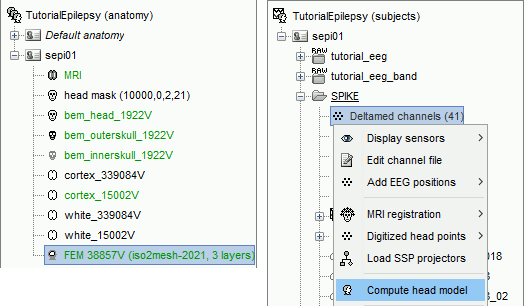
Select MRI volume, EEG: DUNEuro FEM, select all the layers and the default conductivity values (scalp = inside the head surface, skull = inside the outer skull surface, brain = inside the inner skull surface).
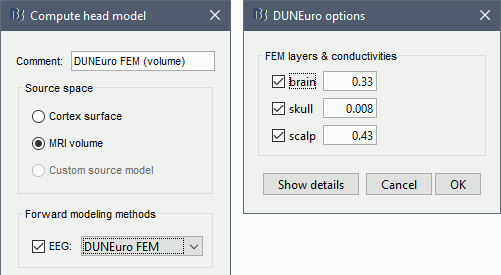
Volume source grid: Regular grid, brain, 5mm.
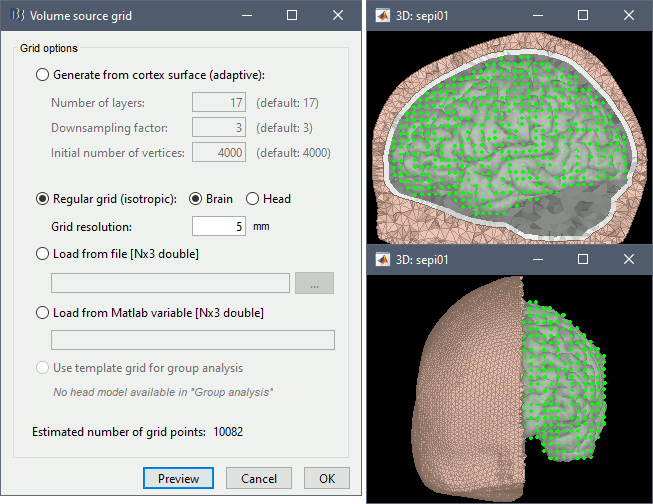
Start the computation. Depending on the complexity of the problem (number of FEM elements, number of layers, number of source points, number of sensors and computation options), this can take anywhere between a few minutes to a few days. In this example, if you selected the correct files and options, it should only take a few minutes. You may be prompted to download or update the bst-duneuro plugin.
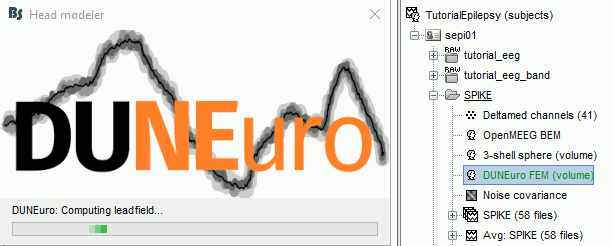
When it's finished, you have obtain a new head model, which can be used for source estimation: see the epilepsy tutorial, the volume source estimation tutorial, or the introduction tutorial.
DUNEuro options: Basic
When assuming isotropic conductivities for all the tissues, the DUNEuro basic options are limited to the selection of the tissues and their conductivities.
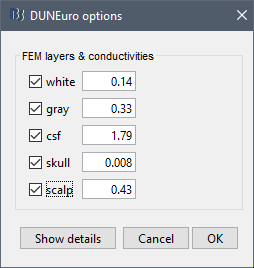
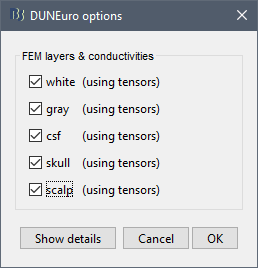
FEM layers: Brainstorm reads the lists of tissues from the selected FEM mesh. Users can select the desired layers to include in the FEM computation. According to the modalities, the recommended selections are:
EEG: Select all the layers
MEG: Select only the inner layers (inside the inner skull = brain = white+gray+csf)
SEEG: Select only the inner layers
ECOG: Select only the inner layers
- Any combination of modalities that includes MEG: select all the layers
FEM conductivities (isotropic): Left figure - Brainstorm proposes default conductivity values for each layer (derived from the SimBio software, see this article). However, you have the possibility to change these values according to your model.
FEM conductivities (anisotropic): Right figure - Advanced users can use information from diffusion imaging exams to estimate anisotropic conductivity tensors for each element of the FEM mesh. For more information, refer to the tutorial: FEM tensors estimation. To remove previously computed tensors and restore the default isotropic approach, right-click on the FEM mesh > Clear FEM tensors.
DUNEuro options: Advanced [TODO]
In the DUNEuro options panel, click on the button Show details to access the advanced options.
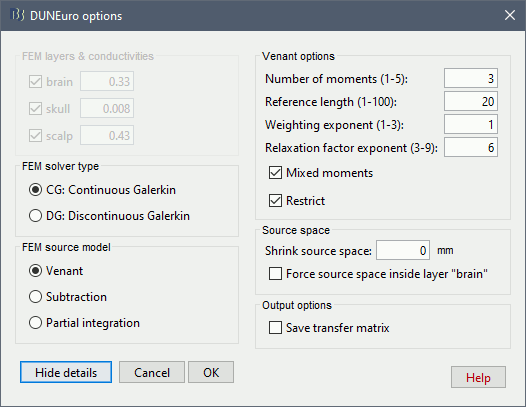
FEM layers & conductivities: Discussed in the previous section.
FEM solver type: (only the fitted FEM are integrated in Brainstorm at the moment)
CG: Continuous Galerkin: the standard Lagrangian method.
DC: Discontinuous Galerkin: method that deals with some problems that appear occasionaly during meshing of very thin volumes. DC enforces a realistic modeling of the volume currents to attempt to mitigate these problems.
FEM source model:
Venant:
- Number of moments:
- Reference length:
- Weighting exponent:
- Relaxation factor exponent:
- Mixed moment:
- Restrict:
Subtraction:
- intorderadd:
- intorderadd_lb:
Partial integration:
Source space:
Shrink source space: The dipoles are moved inward by the specified distance (in mm).
Force source space: This is required when the dipoles are not within the gray matter.
Output options:
Save transfer matrix:
For more information about these methods, users can check Johannes Vorwerk's PhD thesis.
Troubleshooting
DUNEuro binaries may crash for various reasons. We will try to describe the most frequent problems, however, in general terms, FEM forward modeling problems can be related with memory overload or extremely long computation times. For this reason it is always a good idea to reduce the size of the problem and test simpler solutions first, before attempting a fine grained computation.
If you cannot find a solution, please post the full error message on the Brainstorm user forum (you can copy-paste the error message from the Matlab command window after closing the error message box).
Grid error messages
- Explanation: Some dipoles are probably outside of the cortex, users need to correct the source space.
- Try redefining the source model by making sure that the sources are not located out of the cortical volume.
Remove the neck
One way to reduce the size of the forward problem is to decrease the number of FEM elements in the head model. When the field of the MRI is large, you may have the mesh of the neck and even the shoulders. In most cases, it is safe to remove the lower part of the FEM mesh, below the nose and the brainstem. Right-click on the FEM mesh > Resect Neck.
Once the process is finished, a new FEM mesh appears in the database, with a tag "resect". The following figure shows the model before (743828 vertices / 4079587 elements) and after resection (613955 vertices / 3400957 elements). It will reduce the size of the problem by 20%.
Linux Operating Systems:
Some users have reported the following error when computing the head model with DUNEuro in Linux OS.
Error while loading shared libraries: libldl.so.2: cannot open shared object file: No such file or directory
The problem is that DUNEuro requires some libraries in order to work properly. These dependencies should be in a folder where they can be located. The error message occurs when this dependencies eithera are missing in your system or in your path. In order to solve it, you can try to find any library with the same name. Be careful, libdl.so and libldl.so are not the same thing.
find -name "libldl*" /usr
If you find a libldl library, but it is not in the correct path, try copying the library (or a link to it) to /usr/lib.
If you cannot find any related library in your system, try installing the following packages to force that dependency being installed in your system. For instance, in Ubuntu you can run:
sudo apt install libldl2 libspar2 libdune-grid-dev libdune-istl-dev
Additional documentation
Related tutorials
DUNEuro references
DUNEuro wiki: https://gitlab.dune-project.org/duneuro/duneuro/wikis/home
DUNEuro website: https://www.medizin.uni-muenster.de/duneuro/startseite.html
List of the parameters: https://docs.google.com/spreadsheets/d/1MqURQsszn8Qj3-XRX_Z8qFFnz6Yl2-uYALkV-8pJVaM/edit#gid=0
Brainstorm-DUNEuro integration
Brainstorm user forum
Sources in white matter: https://neuroimage.usc.edu/forums/t/each-source-is-in-which-layer-of-the-mesh/31887/10
